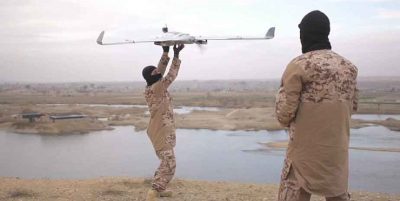Funnelling Weapons and Cash to ISIS: Islamic State Drone Program Study Reveals NATO Ratlines

Note to readers: please click the share buttons above
Despite attempts by the US and European media to depict the self-proclaimed Islamic State (IS) in cartoon villain terms, it was always clear to serious analysis that the terrorist organization’s fighters, weapons, supplies and money were entering Syria and the result of extensive outside support.
A look at any map of the Syrian conflict, regardless of its source over the past 7 years shows IS and other militant groups maintaining territory with corridors leading directly to the borders of Syria’s neighbors, particularly NATO-member Turkey and US allies Israel and Jordan.
There have been direct admissions from the US itself that it played a role in IS’ creation. A 2013 leaked US Defense Intelligence Agency memo (.pdf) would explicitly note that the US and its allies sought the creation of what it then called a “Salafist principality” in eastern Syria, precisely where IS would later establish itself.
There have also been direct admissions that US allies were funneling weapons and cash to IS and other designated foreign terrorist organizations. In a leaked e-mail sent by former US Secretary of State Hillary Clinton to lobbyist John Podesta, she would explicitly claim:
…we need to use our diplomatic and more traditional intelligence assets to bring pressure on the governments of Qatar and Saudi Arabia, which are providing clandestine financial and logistic support to [IS] and other radical Sunni groups in the region.
There have also been more indirect admissions, in which the US and European media have claimed that large amounts of US-provided arms and cash were “accidentally” falling into the hands of IS via supposedly “moderate rebels,” including when large numbers of these so-called moderate rebels would defect to IS.
A 2014 article in the Telegraph titled, “‘Moderate’ Syrian rebels defecting to ISIS, blaming lack of U.S. support and weapons,” would admit:
Western-backed “moderate” rebels fighting jihadists in Syria are refusing to do battle and even defecting for lack of weapons and other promised support, leaders said.
With them, they took US weapons including US-made TOW anti-tank missiles which eventually turned up in large numbers among IS terrorists. An earlier Telegraph article from 2012 would indirectly admit US weapons and cash were falling into Al Qaeda’s Al Nusra Front’s hands through similar “defections.”
Islamic State Drone Program Supplied via Turkey
When IS began employing drones for surveillance, forward observation missions and even to deliver ordnance to targets, questions began being asked just how such a program could be developed by an organization ordinarily depicted by the US and European media as having simply sprung from Syrian and Iraqi sand dunes.
Among those asking these questions, and finding the answers, was the US Army’s Combating Terrorism Center at West Point. In its 2018 report titled, “The Islamic State and Drones: Supply, Scale, and Future Threats” (.pdf), it would note just how drones and other parts and equipment made it to the terrorist organization in Syria.
The report would note:
In October 2014 and December 2014, months after the Islamic State declared the creation of their caliphate in late June of that same year, Sujan – using the alias Peter Soren – purchased four antennas used for drones from Company 3 and a micro-turbine used in radio-controlled planes from Company 4. At Sujan’s request, these two companies shipped these items direct to Sanliurfa, Turkey – a town located an hour’s drive from the Syrian border town of Tal Abyad, which the Islamic State controlled, and around a two-and-half hour drive to the group’s headquarters in Raqqa, Syria.
The report would note that tens of thousands of dollars of drone parts were ordered and to be shipped to Sanliurfa, Turkey before being brought over the border into Syria and onward to IS territory.
It was through this process that IS was able to develop its drone program which the CTC report quotes one US general as claiming included up to as many as 70 drones in the air on certain days. The program would lead directly to several dozen deaths by weaponized drones and indirectly led to many more through their use as forward observers in guiding indirect weapon fire and guiding vehicle-borne improvised explosive devices (VBIED) toward targets.
While the report notes that some shipments were intercepted by the Turkish government, clearly many more made it through. While Western security agencies eventually liquidated those involved in the program in Syria and Iraq and overseas, this was done in late 2015, after Russia’s military intervention and when America’s “Salafist principality” finally faced real exposure and defeat.
The CTC report is another piece in a puzzle revealing who really drives global terrorism and why. That those behind the IS drone program procured components and entire drones through companies and fronts they operated directly at the heart of the Western surveillance state for an entire year before being stopped calls into question either the efficacy of US-European counter-terrorism measures, or the sincerity behind executing them.
Some may be tempted to chalk the creation of IS’ drone program up to incompetence on the part of Western security agencies. The fact remains nonetheless that once again US-European states provided procurement opportunities for IS programs while NATO-member Turkey served as a permissive logistical hub to deliver these supplies and weapons to neighboring Syria. Considering the nature of IS’ original inception and longevity, particularly in areas the US itself claims to be fighting it, it is difficult not to at least consider conspiracy, if not conclude as much.
*
Ulson Gunnar is a New York-based geopolitical analyst and writer especially for the online magazine “New Eastern Outlook”.
Featured image is from the author.

